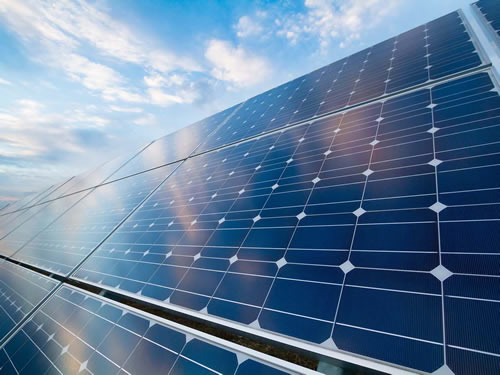In the Tengger Desert of Ningxia, China, the inky-black monocrystalline silicon arrays interlock with sapphire-blue polycrystalline silicon panels, like black and white pieces on a chessboard. This seemingly random layout is, in fact, a precise engineering calculation balancing land costs, light conditions, and return on investment. The century-long rivalry and synergy between monocrystalline and polycrystalline silicon reveal humanity’s evolving mastery of solar energy.
I. The Watershed of Crystal Growth
The birth of monocrystalline silicon resembles a genesis myth for the silicon world—the Czochralski method slowly pulls a perfect crystal lattice from molten silicon at 1600°C. Shin-Etsu Chemical’s 300mm monocrystalline silicon ingots, with crystal defect densities controlled below 1/cm³, are akin to allowing only three grains of sand across the entire area of Tokyo. This extreme purity enables satellite photovoltaic systems to endure 25 years of service in the harsh radiation of space.
Polycrystalline silicon’s directional solidification process showcases a different wisdom. GCL’s casting technology achieves 98% silicon utilization, with grain sizes optimized between 5-20mm. Like a meticulously designed mosaic, carrier recombination rates at grain boundaries are suppressed to 2.3×10³/cm², pushing mass-production efficiency beyond the critical threshold of 18.6%.
II. The Quantum Entanglement of Efficiency and Cost
LONGi’s Hi-MO6 monocrystalline modules set a commercial record of 24.3% efficiency at Dubai’s test field, with surface passivation technology extending ultraviolet response to 300nm. Yet this high performance comes at a cost—30% silicon waste. For every kilogram of silicon ingot, 320 grams become diamond-wire cutting debris, which is reborn in Qinghai’s recycling plants as silicon-carbon anodes for EV batteries.
Polycrystalline silicon’s black silicon technology tells a story of resurgence. JinkoSolar’s wet-etching process carves nanoscale pits onto surfaces, using light-trapping effects to boost rainy-day power generation by 19%. A MIT team’s breakthrough with femtosecond laser-textured subwavelength structures reduced polycrystalline reflectivity to 1.7%, outperforming monocrystalline silicon by 0.3 percentage points.
III. Spatiotemporal Folding of Applications
On the snow-laden roofs of Swiss Alpine resorts, Hanergy’s monocrystalline tiles maintain a delicate balance with snowfall—54° tilt angles enable automatic snow shedding, while hydrophobic coatings reduce dust adhesion by 67%. Each tile’s 21.8% efficiency withstands -40°C extremes, retaining 83% rated power during blizzards.
Polycrystalline silicon demonstrates economies of scale in the Sahara Desert. At Algeria’s 2GW plant, double-glass polycrystalline modules outperform monocrystalline systems by 5.7% in daily output under 60°C ground temperatures. The secret lies in polycrystalline grain boundaries forming natural thermal channels, lowering operating temperatures by 4.2°C.
As monocrystalline N-type TOPCon technology breaches the 26% efficiency barrier and polycrystalline quasi-monocrystalline casting blurs crystal boundaries, this twin-star rivalry transcends mere technical competition. At Tokyo Skytree’s curved photovoltaic facade, monocrystalline strength merges with polycrystalline translucence at the molecular level; in Musk’s Solar Roof, the two materials achieve quantum synergy through smart inverters. The ultimate answer for photovoltaics may lie in the complementary symbiosis of these crystalline siblings.

 Jinko Solar 66HL4M-(V) 610W 615W 620W 630W 635W
Jinko Solar 66HL4M-(V) 610W 615W 620W 630W 635W Jinko Solar 78HL4-BDV Tiger Neo 625W-650W
Jinko Solar 78HL4-BDV Tiger Neo 625W-650W Jinko Solar 54HL4R-BDB Tiger Neo 425W-450W
Jinko Solar 54HL4R-BDB Tiger Neo 425W-450W  Jinko Solar 54HL4R-(V) Tiger Neo 435W-460W
Jinko Solar 54HL4R-(V) Tiger Neo 435W-460W LONGI HI-MOX6 LR7-72HTH 600W-620W
LONGI HI-MOX6 LR7-72HTH 600W-620W LONGI HI-MO7 LR5-72HGD 560W-590W
LONGI HI-MO7 LR5-72HGD 560W-590W LONGI HI-MO7 LR5-72HGD 585W-620W
LONGI HI-MO7 LR5-72HGD 585W-620W Ja Solar JAM72D30/LB 580W 575W 570W 565W Double Glass Bifacial Solar Module Panel
Ja Solar JAM72D30/LB 580W 575W 570W 565W Double Glass Bifacial Solar Module Panel Ja Solar JAM72D30-560/LB MBB Bifacial Mono PERC 560W Double Glass Solar Module
Ja Solar JAM72D30-560/LB MBB Bifacial Mono PERC 560W Double Glass Solar Module Ja Solar JAM72D30-555/LB 555W DEEPBLUE3.0 Solar Module Panel
Ja Solar JAM72D30-555/LB 555W DEEPBLUE3.0 Solar Module Panel Trina Solar Tsm-De09.05 Vertex S 380W-400W
Trina Solar Tsm-De09.05 Vertex S 380W-400W Trina Solar Tsm-DE09C.07 Vertex S 380W-405W
Trina Solar Tsm-DE09C.07 Vertex S 380W-405W Trina Solar Tsm-DE09C.05 Vertex S 380W-405W
Trina Solar Tsm-DE09C.05 Vertex S 380W-405W Trina Solar Tsm-NEG09RC.05 400W-430W
Trina Solar Tsm-NEG09RC.05 400W-430W Canadian Solar 520W-550W Bifacial Mono Solar Panel
Canadian Solar 520W-550W Bifacial Mono Solar Panel Canadian Solar 695W Pallet of TOPcon Solar Panels
Canadian Solar 695W Pallet of TOPcon Solar Panels Canadian Solar 605W N-type Bifacial TOPCon Solar Panels
Canadian Solar 605W N-type Bifacial TOPCon Solar Panels Canadian Solar 450W 108 Cells TOPCon BoB Solar Panel
Canadian Solar 450W 108 Cells TOPCon BoB Solar Panel


